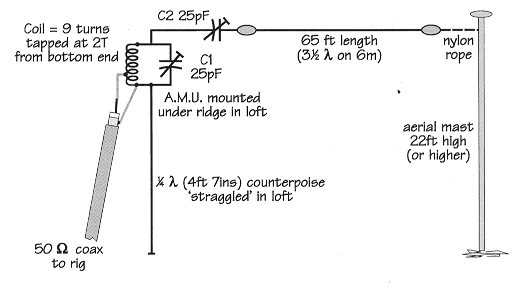Brian D. Williams, GW0GHF
Issue, 56 February 1998
Having had the time to evaluate it, I find this aerial very useful for both semi-local and sporadic-E on six metres.
The antenna is about 65 feet of ordinary aerial wire, insulated at the far end. The near end connects to a matching unit situated in the loft of the house. The aerial wire enters the loft under a tile near the ridge of the roof of the house, through an insulating sleeve.
 The theoretical diagram.
The theoretical diagram.
The aerial is voltage-fed (high impedance) and the antenna matching unit (AMU) transforms this to match 50 ohm cable. The two trimmers are ‘polycon’ variables - these are OK up to 50 watts. For operation at higher powers, obviously more substantial trimmers, such as mica compression types, will be needed. Old radio receivers of the 1950 vintage or before are often a source of these types of trimmer. ‘Cirkit’ can supply them, but they are not cheap! The trimmers are likely to be the only ‘expensive’ parts required for this antenna, however.
The method of adjustment is to set C2 to half capacity and then adjust C1 for best noise on receive. Then feed in a carrier (or an audio tone on SSB) and adjust C1 for a low SWR reading. 1:1 is achievable at this QTH.
No problems with ‘RF in the shack’ have been encountered at 50 watts SSB. The counterpoise were effectively ‘earths’ the bottom end of the parallel-tuned circuit; it hangs from the AMU in the loft. It is 4ft 6in in length.
The AMU is constructed on a tobacco-tin lid. The coil is nine turns of 18 SWG copper wire taken from old coax cable. It is 3/8 inch in diameter, spaced over approximately ¾ inch.
Increasing C2 too much will prevent the tuned circuit from resonating at 50MHz. This, in turn, depends on the capacitance of the whole aerial wire to earth - but no problems were found and it was easy to get unity SWR. Shorting out C2 might be acceptable if a low-capacity system can be constructed, but this did not work at my QTH.
The wire gives a gain of 4 dB in four directions at 35 degrees to the run of the wire. There are also several smaller lobes which are useful. This is a good ‘listening’ antenna with gain that can be arranged in desired directions.